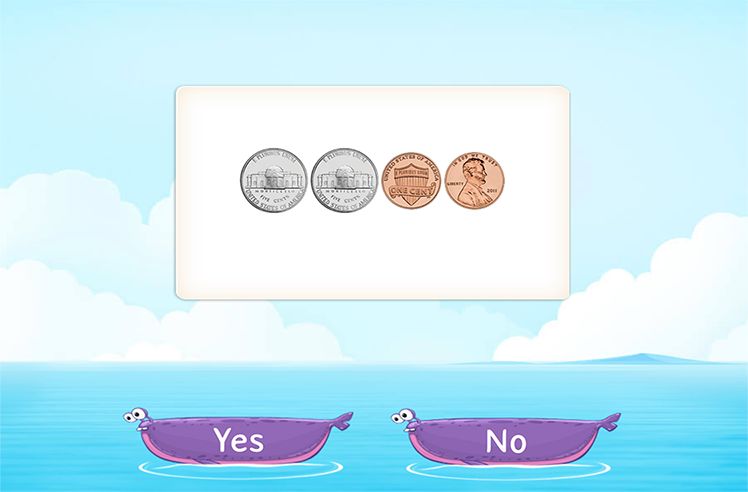Definition of Fractions
Fractions are expressed in mathematics as a number value that defines a part of a whole or group of objects. Fraction is a component or sector of a given quantity taken from the whole, which might be a number, a specified value, or an item.
A fraction represents a part of the whole or group of objects.In a fraction, numerator (top number) and denominator (bottom number) are separated by a horizontal bar known as the fractional bar. The denominator represents the number of equal parts the whole is divided into or total number of objects in a group. The numerator represents the number of parts of the whole or the number of objects from the group is taken.
Let us better understand fractions with the help of an example. A chocolate bar is divided into four equal parts. Each part of the whole bar represents $\frac{1}{4}$ , which depicts 1 out of 4 equal parts. The fraction ¼ is read as ‘1 by 4’.

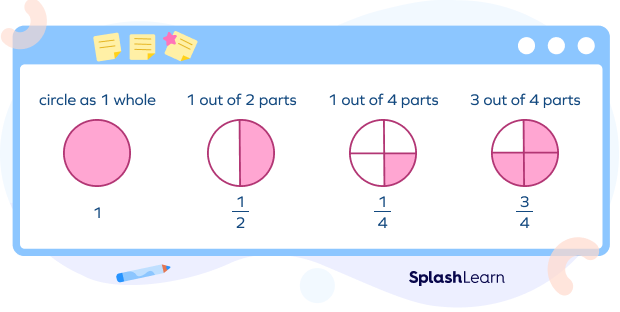
Recommended Games
Types of Fractions
Fractions are differentiated on the basis of the numerators and the denominators. Fractions are classified into the following types:
- Unit Fractions: Fractions with numerator 1 are called unit fractions.
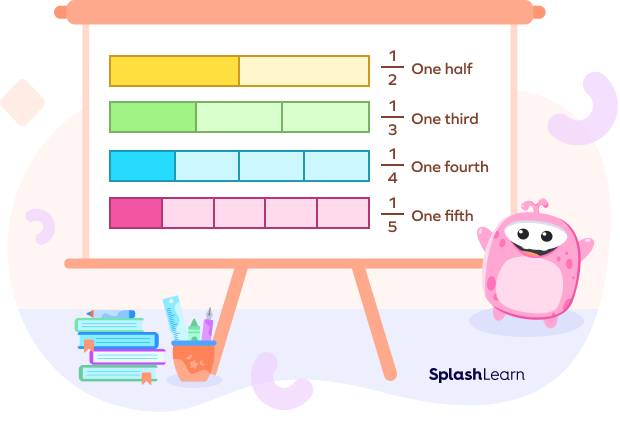
- Proper Fractions: Fractions in which the numerator is less than the denominator are called proper fractions. A proper fraction is less than 1
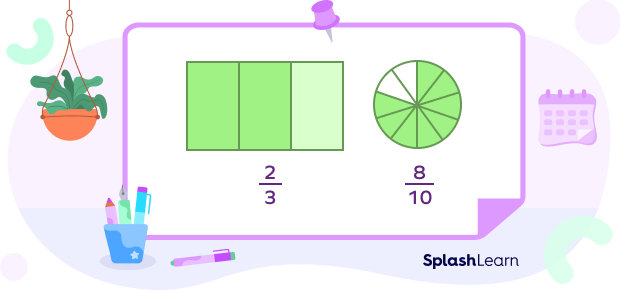
- Improper Fractions: Fractions in which the numerator is more than or equal to the denominator are called improper fractions. An improper fraction is greater than 1.

- Mixed Fractions: Mixed fractions consist of a whole number and a proper fraction. Since mixed fractions are combinations of whole numbers and a fraction, mixed fractions are always greater than 1.
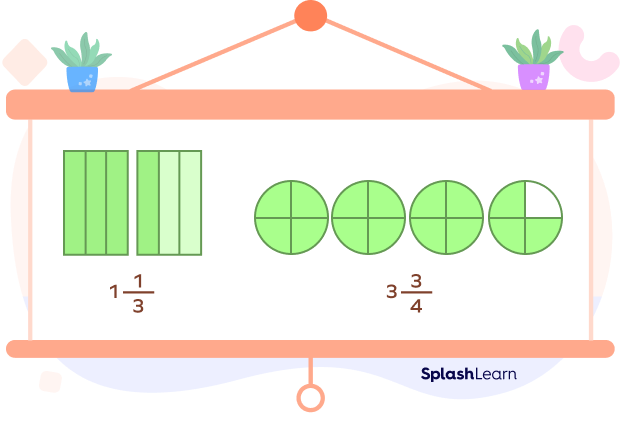
- Like Fractions:
Fractions with the same denominators are called like fractions.
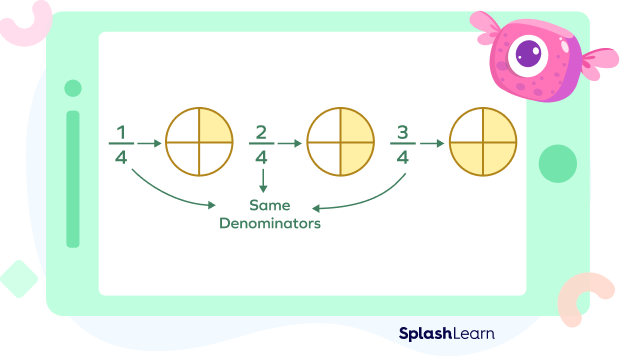
- Unlike Fractions:
Fractions with different denominators are called unlike fractions.
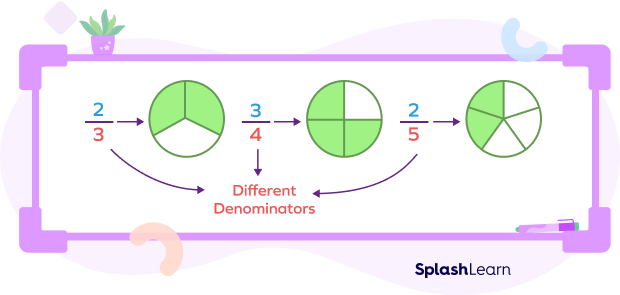
- Equivalent fractions: Fractions that represent the same value after being simplified are called equivalent fractions. To get equivalent fractions we can multiply or divide both the numerator and the denominator of the given fraction by the same number.
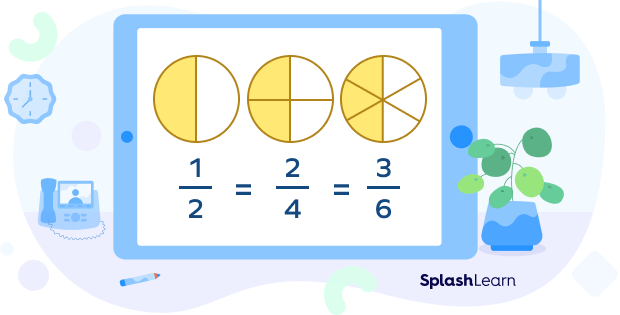
Recommended Worksheets
Solved Examples
- John coaches the baseball league team. There are 10 players on the team. Four of them bat left-handed. What fraction of the players are right-handed?
Solution:
Number of right handed players = 10 − 4 = 6
6 out of the 10 players are right-handed, so six-tenths or $\frac{6}{10}$ of the players are right-handed.
- State true or false.
$\frac{4}{9}$ is an improper fraction
Solution:
False. The fraction $\frac{4}{9}$ has numerator 4 and denominator 9. Since the numerator is less than the denominator, $\frac{4}{9}$ is a proper fraction. A fraction with numerator more than or equal to the denominator is an improper fraction.
- Find the value for x.
$\frac{7}{9}$ = $\frac{x}{36}$
Solution:
$\frac{7}{9}$ and $\frac{x}{36}$ are equivalent fractions.
So, $\frac{x}{36}$ = $\frac{7}{9}$ = $\frac{7 ✕ 4}{9 ✕ 4}$ = $\frac{28}{36}$
Therefore, x must be 28.
- What is the simplest form of $\frac{30}{45}$?
Solution:
Greatest common factor of 30 and 45 is 15. Divide both the numerator and the denominator by 15 we get
$\frac{30}{45}$ = $\frac{30 \div 15}{45 \div15}$ = $\frac{2}{3}$
Since 2 and 3 do not have a common factor, $\frac{2}{3}$ is in the simplest form.
Practice Problems
Types Of Fractions
Which of the following is a fraction equivalent to $\frac{2}{5}$?
$\frac{2}{5} = \frac{2 \times2}{5 \times2} = \frac{4}{10}$
Which of the following has 11 as numerator?
$\frac{11}{17}$ has numerator 11 and denominator 17
Fill in the blank.
$\frac{1}{4}$, $\frac{2}{8}$, $\frac{3}{12}$, $\frac{4}{16}$ are _______
$\frac{1}{4}$ = $\frac{2}{8}$ = $\frac{3}{12}$ = $\frac{4}{16}$
Which of the following is unit fraction?
The numerator of unit fraction is 1.
Frequently Asked Questions
Where are fractions used in real life?
In following recipes, scores of test or exam, fractions of liquid in mocktails.
What type of fraction have different denominators?
Fractions with different denominators are called unlike fractions. For example, 7/9, 2/5, 3/6 are unlike fractions and they have different denominators.
Do fractions have a greater number on the numerator than denominator?
Yes, they do. A fraction in which the numerator is greater than or equal to the denominator is called an improper fraction.
Why is it preferable to simplify fractions down to their lowest possible form?
Simplified or lowest form or reduced form of a fraction makes the calculation easier.
Conclusion
It is possible to learn much more about fractions, through interactive experiences exploring new worlds, and befriending magical creatures. Visit SplashLearn to make studying for your kids or students fun and simple!
















